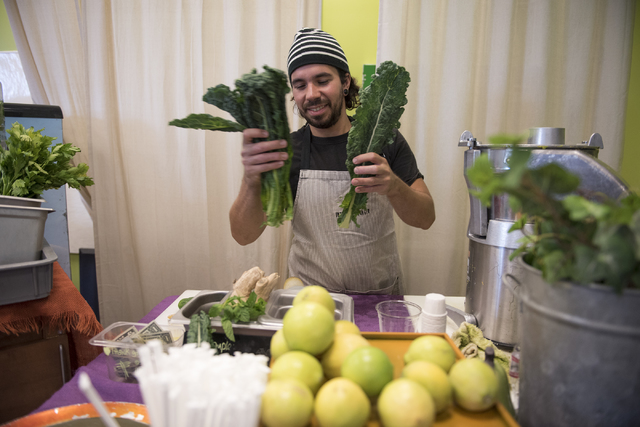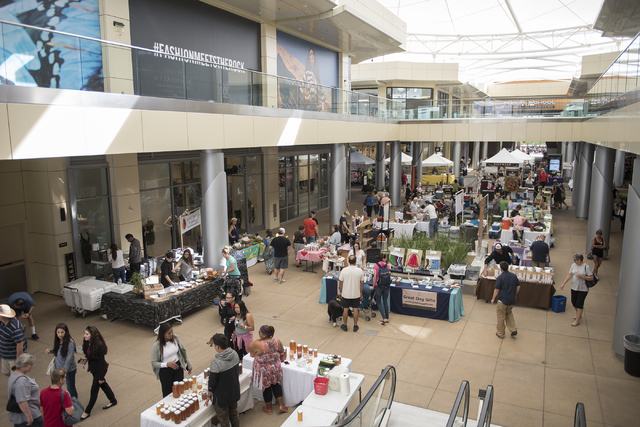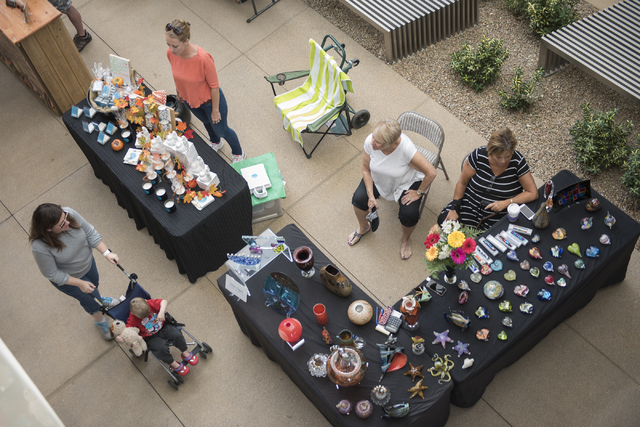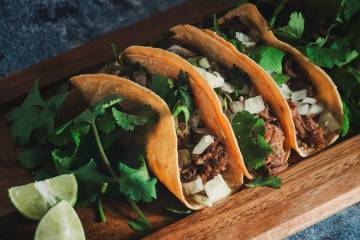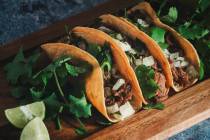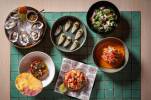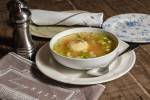Easy tips for finding your way around Las Vegas Valley farmers markets
Stroll through a local farmers market and you may discover more bountiful options than ever before.
At last week’s Las Vegas Farmers Market at Bruce Trent Park, merchants offered local honey, exotic meats, freshly baked breads and cookies, and dog treats. A musician performed and French and Brazilian food trucks provided olfactory competition to the fresh evening air.
And, of course, there was produce. Lots and lots of produce.
The variety — and the differences between farmers markets and conventional supermarkets — can be a little daunting, especially considering there are at least nine markets in the valley each week. But market veterans and other experts have tips on how to get the most from them.
As do a beginner or two. Cheryl Hume said she was on her first visit to the market at Bruce Trent Park, but she’d already figured out a few things.
“Make the rounds all the way around before buying anything,” advised Hume, who was leading her spaniel/Chihuahua, Joy, through the numerous human/dog pairings at the park. “It’s a fun place to walk around and get samples.”
It’s also a great place to overhear things, such as the vendor who promised, “There’ll be bigger beefsteaks next week.”
But you don’t have to wait to eavesdrop; veterans suggest talking to the vendors to get the best products and deals.
“I think one of the most important things is knowing where it’s sourced from,” said Nicole Brisson, culinary director for the B&B Restaurant Group in Las Vegas. B&B, owned by Mario Batali and Joe Bastianich, is known for using local produce whenever possible.
“You have to do the legwork on your own to find out exactly where it’s coming from,” Brisson said. “There’s a lot of smoke and mirrors when it comes to supermarkets and even some of the specialty food stores.”
Kerry Clasby, the self-described “intuitive forager” who operates the Downtown 3rd and Downtown Summerlin farmers markets and supplies dozens of local chefs, agreed.
“Ask, ‘Where do you grow?’ ” Clasby said. “There are a lot of so-called growers that are buying from other growers. Which is not actually a problem, but you want to know the source. Ask, ‘Where else do you sell? How do you make a living?’”
That’s a good way to find out about growing conditions as well.
“I always ask, ‘What do you do for weed control?’ ” Clasby said. “They all say they don’t use Roundup. ‘So what do you use?’ You’ll see how deep the question goes. It’s good to ask those questions, because we don’t need extra pesticides and chemicals in our food.”
Talking to the vendors also is a good way to save money.
“Ask them directly, ‘What do you need to sell? What do you have extra?’ ” Clasby said.
“If you talk to the vendors, sometimes they have some ugly fruits and vegetables that are quite tasty,” said Aurora Buffington, a faculty instructor for Nevada Cooperative Extension. “And if you wait until the end of the market, sometimes you can get a good deal. You’re not going to get the best selection. Get there early if it’s important to you to get that special fruit or vegetable.”
Knowing where your produce comes is another way to save money.
“To get the best bang for your buck, look for local products,” said Marcia Godfrey, owner of Blue Moon Harvest in Pahrump. “There’s no middleman. Nobody’s shopping and buying and taking it by the truckload somewhere.”
They also said if at all possible, go to more than one farmers market.
“If transportation isn’t an issue and you have the time, there’s a market every day of the week except Mondays and Tuesdays,” Buffington said. “If it’s near your work — if it’s convenient — why not check out the market? You’ll be surprised; a lot of the prices are comparable to the ones in the stores.”
Those who receive SNAP benefits — from the federal Supplemental Nutrition Assistance Program — can use their cards at all local farmers markets except the one in Downtown Henderson, Buffington noted. And under a current program, for every $5 a recipient swipes, they’ll get a bonus to spend on fruits and vegetables.
While most farmers market vendors used to accept only cash, she said most now take debit or credit cards.
Godfrey, who grows greens including spinach, romaine, collards, arugula, chard and kale, and sells at the Downtown 3rd and Downtown Summerlin farmers markets, said good producers will have seasonal crops; educate yourself on what’s in season to get the best product and value.
Clasby said California growers currently have a surplus of tomatoes, and Nevada growers are moving into winter crops such as lettuces, beets and squashes, as well as “beautiful rhubarb from Pahrump.”
Brisson said she’s seen increased consumer awareness.
“I think there’s a general movement from consumers that they’re caring more about what they’re purchasing,” she said. “I think the drive is from the consumer.”
And while, as Buffington pointed out, you wouldn’t be likely to find, say, tropical fruit at a farmers market — because it doesn’t grow here — there are plenty of choices.
“The beautiful thing about these local growers is that there’s such diversity,” Clasby said. “I’m surprised and overjoyed every week.”
Here are a couple of ideas for using autumn’s bounty.
APPLE-CRANBERRY PIE
2 cups fresh or frozen cranberries
¼ cup orange juice
1 cup granulated sugar, plus 1 tablespoon for top of pie
½ teaspoon ground cinnamon
½ teaspoon table salt
¼ cup water
1 tablespoon cornstarch
3½ pounds sweet apples (6 to 7 medium), peeled, cored and cut into ¼-inch-thick slices (see note)
Dough for double-crust pie
1 egg white, beaten lightly
Bring cranberries, juice, ½ cup sugar, ¼ teaspoon cinnamon and ¼ teaspoon salt to boil in medium saucepan over medium-high heat. Cook, stirring occasionally and pressing berries against side of pot, until berries have completely broken down and juices have thickened to jamlike consistency (wooden spoon scraped across bottom should leave clear trail that doesn’t fill in), 10 to 12 minutes. Remove from heat, stir in water and cool to room temperature, about 30 minutes.
Meanwhile, mix ½ cup sugar, remaining ¼ teaspoon cinnamon, remaining ¼ teaspoon salt and cornstarch in large microwave-safe bowl; add apples and toss to combine. Microwave on high power, stirring with rubber spatula every 3 minutes, until apples are just starting to turn translucent around edges and liquid is thick and glossy, 10 to 14 minutes.
Cool to room temperature, about 30 minutes.
While fillings cool, adjust oven rack to lowest position, place rimmed baking sheet on oven rack and heat oven to 425 degrees. Fit bottom crust into pie plate, leaving at least 1 inch overhang. Refrigerate until dough is firm, about 30 minutes.
Transfer cooled cranberry mixture to dough-lined pie plate and spread into even layer. Place apple mixture on top of cranberries, mounding slightly in center; push down any sharp apple edges.
Roll second disk of dough on generously floured work surface (up to ¼ cup) to 12-inch circle about 1/8 inch thick. Roll dough loosely around rolling pin and unroll over pie, leaving at least 1-inch overhang on each side.
Fold edges of dough under and flute. Brush top and edges of pie with egg white and sprinkle with remaining tablespoon sugar. Using sharp paring knife, cut four 1½-inch slits in top of dough in cross pattern.
Place pie on preheated baking sheet and bake until top is light golden brown, 20 to 25 minutes. Reduce oven temperature to 375 degrees, rotate baking sheet, and continue to bake until crust is deep golden brown, 25 to 30 minutes longer. Transfer pie to wire rack to cool at least 2 hours.
Note: Use sweet, crisp apples, such as Golden Delicious, Jonagold, Fuji or Braeburn. The two fillings can be made ahead, cooled, and stored separately in the refrigerator for as long as 2 days.
Makes 1 9-inch pie.
— Cook’s Illustrated
CURRIED ROASTED SQUASH SOUP
1 kabocha or butternut squash (2½ pounds)
2 tablespoons butter, melted
2 teaspoons curry powder
1 large unpeeled onion, cut in half
3 cups vegetable or chicken broth
1 teaspoon salt
¼ to ½ teaspoon cayenne
About 4 tablespoons plain yogurt
Preheat oven to 350 degrees. Cut squash in half lengthwise with large heavy knife (use a hammer or flat mallet to help drive the blade through). Scoop out seeds.
Mix butter and curry powder and brush over cut surfaces of squash and onion. Put squash and onion, cut sides down, on a rimmed baking pan. Bake until soft when pressed, about 1 hour.
Scoop flesh out of squash and remove skin from onion. Chop onion. Puree squash and onion in blender or food processor, in batches and holding lid down with a towel, with 3 cups broth and any juices from baking pan. Pour into a large pot and thin with more broth if you like. Add salt and cayenne and cook, stirring, over medium-high heat until hot.
Divide among serving bowls and top each bowl with about 1 tablespoon yogurt.
Serves 4.
— Sunset magazine
Contact Heidi Knapp Rinella at Hrinella@reviewjournal.com. Find more of her stories at www.reviewjournal.com, and follow @HKRinella on Twitter.
Local farmers markets
Downtown 3rd Farmers Market, 9 a.m. to 2 p.m. Fridays indoors at 300 N. Casino Center Drive, off U.S. Highway 95 South and Casino Center Drive.
Downtown Summerlin Farmers Market, 9 a.m. to 2 p.m. Saturdays in the Pavilion at Downtown Summerlin, near the 215 Beltway between Sahara Avenue and Charleston Boulevard.
Fresh52 Farmers Market, 9 a.m. to 2 p.m. Saturdays at Tivoli Village, 440 S. Rampart Blvd., and 8:30 a.m. to 1 p.m. Sundays at Sansone Park Place, 9480 S. Eastern Ave. in Henderson.
Henderson Farmers Market, 9 a.m. to 4 p.m. Thursdays at 240 S. Water St. in downtown Henderson and 9 a.m. to 4 p.m. Fridays at Henderson Pavilion, 200 S. Green Valley Parkway.
Las Vegas Farmers Market, 4 to 8 p.m. Wednesdays at Bruce Trent Park, 1600 N. Rampart Blvd.; 4 to 8 p.m. Thursdays at Gardens Park, 10401 Garden Park Drive; and 10 a.m. to 2 p.m. on the first and third Saturday of every month at Floyd Lamb Park at Tule Springs, 9200 Tule Springs Road.
On the Ranch Farmers and Artisan Market, 9 a.m. to 2 p.m. Sundays in the Gardens Plaza parking lot at Craig Ranch Regional Park, 628 W. Craig Road in North Las Vegas.






